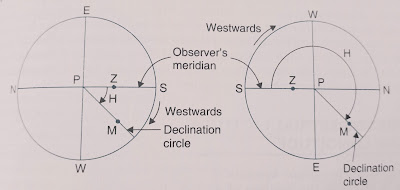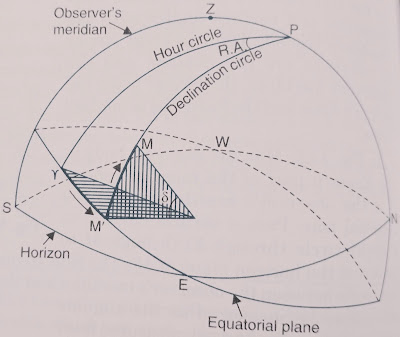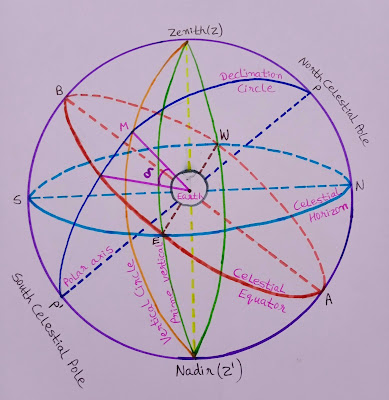Terrestrial Poles and Equator:
The terrestrial poles are the two points in which the earth’s axis of rotation meets the earth’s sphere.
The terrestrial equator is the great circle of the earth, the plane of which is at right angles to the axis of rotation. The two poles are equidistant from it.
The Celestial Sphere:
The Zenith and Nadir:
Great Circle:
Great circle is a section of a sphere when the cutting plane passes through the centre of the sphere.
Celestial Poles and Equator:
If the earth’s axis of rotation is produced indefinitely, it will meet the celestial sphere in two points called the north and south celestial poles (P and P’). The celestial equator is the great circle of the celestial sphere in which it is intersected by the plane of terrestrial equator.
 |
| Fig. CELESTIAL,SENSIBLE & VISIBLE HORIZON |
The Celestial Horizon:
The Celestial Horizon is also called True or Rational horizon or geocentric horizon.
It is the great circle traced upon the celestial sphere by that plane which is perpendicular to the Zenith-Nadir line, and which passes through the centre of the earth.
The Sensible Horizon:
It is a circle in which a plane passing through the point of observation and tangential to the earth’s surface (or perpendicular to the Zenith-Nadir line) intersects with celestial sphere. The line of sight of an accurately levelled telescope lies in this plane.
The Visible Horizon:
It is the circle of contact, with the earth, of the cone of visual rays passing through the point of observation. The circle of contact is a small circle of the earth and its radius depends on the altitude of the point of observation.
Vertical Circle:
A vertical circle of the celestial sphere is great circle passing through the Zenith and Nadir. They all cut the celestial horizon at right angles.
The Observer’s Meridian:
The meridian of any particular point is that circle which passes through the Zenith and Nadir of the point as well as through the poles. It is thus a vertical circle.
The Prime Vertical:
It is that particular vertical circle which is at right angles to the meridian, and which, therefore passes through the east and west points of the horizon.
The Latitude (θ):
It is the angular distance of any place on the earth’s surface north or south of the equator, and is measured on the meridian of the place. It is marked + or- (or N or S) according as the place is north or south of the equator. The latitude may also be defined as the angle between the zenith and the celestial equator.
 |
| Fig. LATITUDE AND LONGITUDE |
The Co-latitude (c):
The Longitude (Φ):
The longitude of a place is the angle between a fixed reference meridian called the prime or first meridian and the meridian of the place. The prime meridian universally adopted is that of Greenwich. The longitude of any place varies between 0° to 180°, and is reckoned as 6° east or west of Greenwich.
 |
| Fig. AZIMUTH & ALTITUDE |
The Altitude (α):
The altitude of celestial or heavenly body (i.e., the sun or a star) its angular distance above the horizon, measured on the vertical circle passing through the body.
The Co-altitude or Zenith Distance (z):
It is the angular distance of heavenly body from the zenith. It is the complement of the altitude, i.e., z = (90° – α).
The Azimuth (A):
The azimuth of a heavenly body is the angle between the observer’s meridian and the vertical circle passing through the body.
The Declination (δ):
The declination of a celestial body is angular distance from the plane of the equator, measured along the star’s meridian generally called the declination circle, (i.e., great circle passing through the heavenly body and the celestial pole). Declination varies from 0° to 90°, and is marked + or – according as the body is north or south of the equator.
Co-declination or Polar Distance (p):
It is the angular distance of the heavenly body from the nearer pole. It is the complement of the declination, i.e., p = 90° – δ.
Hour Circle:
Hour circles are great circles passing through the north and south celestial poles. The declination circle of a heavenly body is thus its hour circle.
 |
| Fig. HOUR ANGLE |
The Hour Angle:
The hour angle of a heavenly body is the angle between the observer’s meridian and the declination circle passing through the body. The hour angle is always measured westwards.
 |
| Fig. RIGHT ASCENSION |
The Right Ascension (R.A.):
It is the equatorial angular distance measured eastward from the First Point of Aries to the hour circle through the heavenly body.
Equinoctial Points:
The Elliptic:
Elliptic is the great circle of the heavens which the sun appears to describe on the celestial sphere with the earth as a centre in the course of a year. The plane of the elliptic is inclined to the plane of the equator at an angle (called the obliquity) of about 23° 27′, but is subjected to a diminution of about 5″ in a century.
Solstices:
Solstices are the points at which the north and south declination of the sun is a maximum. The point C at which the north declination of the sun is maximum is called the summer solstice, while the point C’ at which south declination of the sun is maximum is known as the winter solstice. The case is just the reverse in the southern hemisphere.



